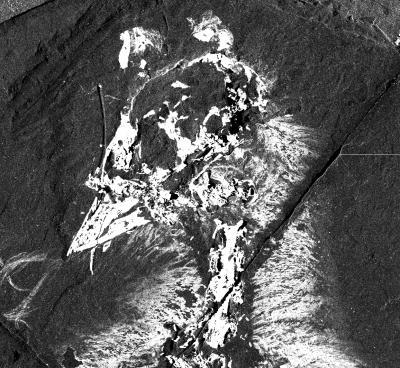Scientists had previously found melanosomes, the biological "paint pots" where melanin pigments are made and stored, in both ancient and living organisms. They used information about the structures of the melanosomes to make an educated guess about the colors of the pigments inside. But newly published research shows that this prior approach has limitations.
The team looked instead for chemical traces of the pigments themselves with two X-ray techniques developed at SSRL.
The first technique identifies specific chemicals or elements in a sample, and it can examine whole fossils rather than the tiny fragments used in previous methods, revealing pigment patterns across the whole specimen. With it, the researchers unveiled traces of specific elements in and around the tissues, bones and surrounding rock of Confuciusornis sanctus. These traces provide an image of the pigmentation patterns from this long-dead bird in eerie detail.
The most striking of these trace elements was copper. Copper, which can be toxic in high levels, has persisted in the fossil in significant amounts, appearing in the images as a ghostly glow in places where feathers remained. What was it doing there? Before they could answer that, the researchers had to determine what chemical form the copper took.
SSRL staff scientist Sam Webb used the second X-ray imaging technique to study the fossil of a single feather from Gansus yumenensis. His analysis revealed that the copper in the fossil took the same form as copper trapped by eumelanin pigment. What's more, Webb said, "When we looked outside the feather we didn't see the copper at all."

A synchrotron rapid scanning x-ray fluorescence image of the calcium distribution in a fossil specimen of Confuciusornis sanctus, an ~120 million year old avian species, the oldest documented to display a fully derived beak. Calcium is high in the bones as shown by the bright white areas, but calcium is also high in the areas corresponding to residue of downy feathers in the neck region. This is interpreted to be due to the distribution of calcium being controlled by eumelanin chelates in the neck feathers, indicating that these soft tissues were originally darkly pigmented. Credit: Data were collected at SLAC's Stanford Synchrotron Radiation Lightsource, image created by Gregory Stewart (SLAC).
Couple that chemistry with the way the copper was distributed, and the research team was faced with a mind-boggling conclusion: They had seen actual color patterns in the fossil bird feathers. The team found the same relationship between copper and pigments in samples from modern feathers and squid.
"These new techniques for teasing out evidence of pigmentation will take a lot of the guesswork out of reconstructing the appearance of extinct dinosaurs and birds," said dinosaur illustrator James Gurney, author of the best-selling Dinotopia series.
The discovery opens a window on the biochemistry of ancient creatures, and could lead to a far greater understanding of what they ate and the chemistry of their surroundings.

Artist’s conception of the pigmentation patterns in Confuciusornis sanctus, an ~120 million year old species, the oldest documented to display a fully derived avian beak. Patterns are based on chemical maps of copper and other trace metals in several fossils of this organism. Trace metals, copper especially, are found to exhibit patterns which reveal eumelanin pigment distribution in the living organism. In the background is a picture of one of the fossils used to derive the artist’s drawing. Drawing of C. sanctus is by Richard Hartley, University of Manchester. Photo by T. Larson, courtesy of the Black Hills Institute. Image created by Gregory Stewart, SLAC National Accelerator Laboratory.
"The fossils we excavate have vast potential to unlock many secrets about the original organism's life, death and subsequent events impacting its preservation," said paper co-author Phil Manning, a paleontologist at the University of Manchester. "In doing this, we unlock much more than just paleontological information. We now have a chemical roadmap to track similar pigments in all life."





Comments